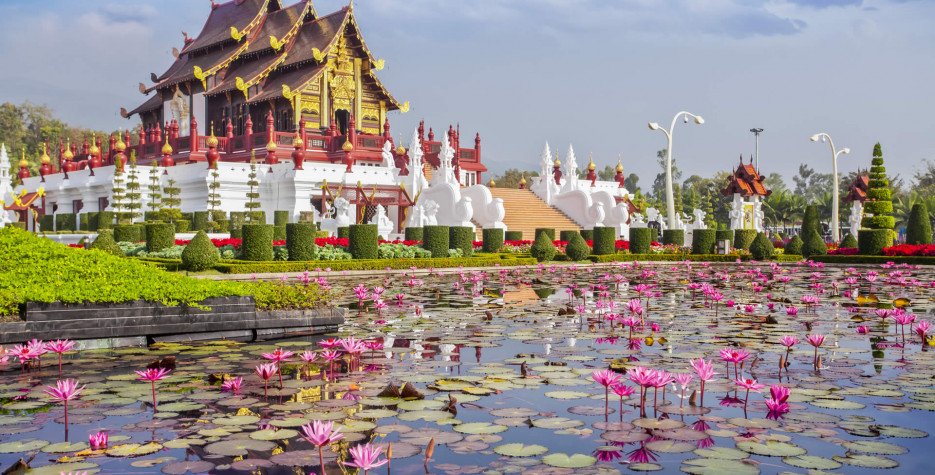Thailand truly has it all–the chaotic charm of Bangkok, the epic tropical jungles, some of the best street food in the world, and palm-lined beaches that seem to go on forever. Whatever your reason for escaping to the Land of Smiles, Thailand won’t disappoint.
Thailand is home to well-connected trains and budget airlines that can take you from one point of interest to the next quickly and effectively. If you’re researching destinations and things to do on your next tropical vacation, check out our list of the best places to visit in Thailand.
Chiang Mai

Shrouded in misty, jungly mountains, Chiang Mai is one of the best destinations in Thailand for travelers looking to see a different side of the country–a city of ancient constructions, thick tropical rainforests, and hill trekking. A good way to see the wild side of Chiang Mai is to head out to Doi Inthanon National Park, which is part of the Himalayan mountain range and home to remote villages and stunning viewpoints.
Chiang Mai is home to more active Buddhist temples than any other city in Thailand, including the famous Doi Suthep (a favorite viewpoint with impressive views over downtown), Wat Phra Singh, and Wat Phra That Doi Suthep. Just outside of the city, you’ll also find a number of hill tribes, including the Meo Hill tribe and the Karen tribe–organized tours can take you there to learn more about their history and lifestyle and to buy handicrafts tribe members sell to sustain themselves.
While in town, take a walk down San Kamphaeng Road, a 10-kilometer-long road where local crafters congregate to sell everything from celadon pottery to lacquerware to silk products.
Bangkok

Thailand’s capital is a fast, buzzing city of over eight million people. Known for its cosmopolitan feel and vibrant street life, Bangkok is also a great gateway to the country’s best temples and palaces. And while it’s easy to forget when walking among Bangkok’s skyscrapers, the city’s heart is on the water–the many canals networking throughout the neighborhoods and the vibrant Chao Phraya River, which you can tour on a long-tail boat cruise.
For those in a shopping mood, Bangkok is home to many shopping centers, including über-luxurious Siam Paragon and travel-inspired Terminal21, as well as a number of traditional floating markets. For a more unique experience, nothing can beat Chatuchak Market — one of the largest outdoor markets in the world and a labyrinth of over 8000 stalls (be prepared for the inevitable experience of getting lost there), Chatuchak has it all and sells it at local prices.
At the top of the things to do in Bangkok is the Grand Palace, a complex of buildings that include Wat Phra Kaew (Temple of the Emerald Buddha), the Royal Reception Halls, and Wat Pho–which houses a 46-meter-long reclining Buddha covered in gold leaf.
Lumpini Park, located in the heart of the city, extends like a green oasis in the concrete jungle that is Bangkok. Often missed by visitors, the park is a great place to see local life–from seniors practicing Thai Chi near the lake (where you can rent boats to paddle away the afternoon) to massive water monitor lizards.
Koh Samui

Home to some of the best palm-fringed beaches in Thailand and plenty of luxury resorts, Koh Samui has a lot more to offer than sunbathing heaven.
One of the most popular holiday spots in Thailand, Koh Samui is home to mountainous rainforests, postcard-worthy beaches, and breathtaking sunsets. There are also plenty of spas and temples to discover here, including the famous Wat Phra Yai and its 12-meter-tall Big Buddha.
Koh Samui’s neighboring archipelagos also have much to offer and are just a quick ferry ride away. Koh Tao, a smaller island right off the coast of Koh Samui, is one of the prime scuba diving destinations in Thailand. Ang Thong National Marine Park (which extends over 42 islands in the area) is a protected area, home to many exotic animal species and a perfect destination for trekking through the thick Thai jungle.
Ayutthaya
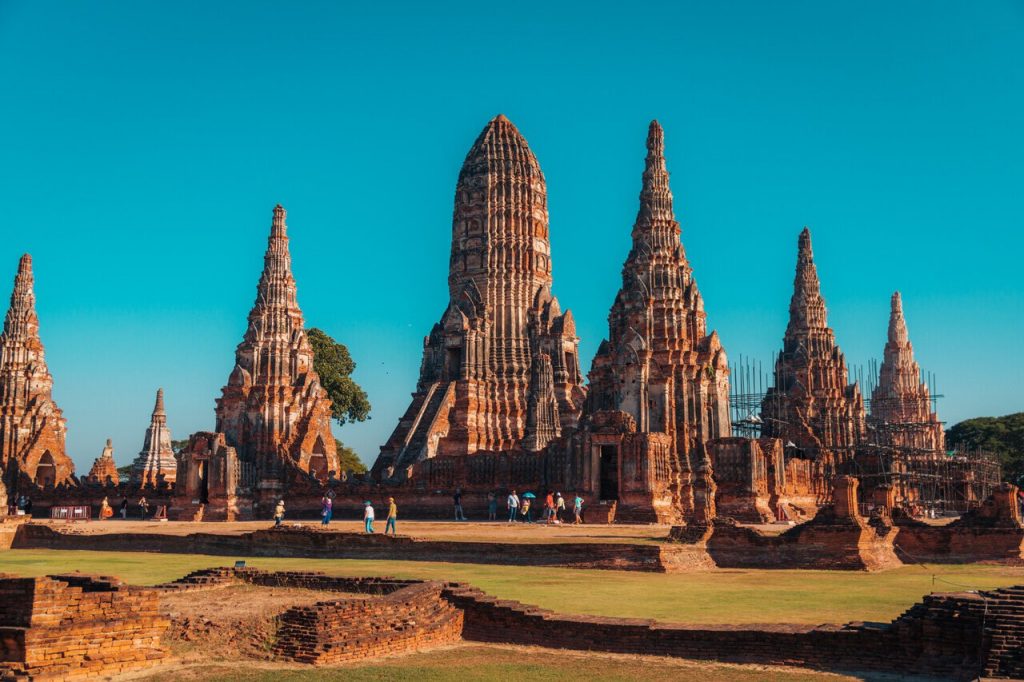
Located about 80 kilometers north of Bangkok, the ancient city of Ayutthaya was once Thailand’s capital–back in the 14th century, when the kingdom of Siam was at its strongest.
Today, the ruins of the kingdom can be toured while walking the Ayutthaya Historical Park, a UNESCO site. Home to many prang (reliquary towers), wat, and stucco statues, the park is surrounded by three rivers and deep moats and covers an area of 289 hectares.
Wat Phra Mahathat is perhaps the most famous temple here thanks to a statue of a Buddha’s head entwined in tree roots. Wat Phra Si Sanphet, the largest of the temples in the park, features three large silver-looking Chedis, while Wat Yai Chai Mongkol is best known for its giant reclining Buddha and the hundreds of sitting Buddha statues surrounding the temple, all draped in golden cloth.
Krabi

Over 200 islands make up Krabi province, with a significant amount of land now designated as national parks. The region is home to some of the best beaches in Asia. Krabi’s coast is also rugged, characterized by vertical steep limestone cliffs that are very popular with climbers. Stunning Railay Beach, in particular, attracts climbers from all over the world, though it’s also famous for its caves.
The Phi Phi Islands are surrounded by limestone rocks and offer coral-fringed waters and some of the best snorkeling in Thailand. Sailing, kayaking, and bird-watching are popular here. Visitors looking for some land activities can head inland to explore Thung Teao Forest Natural Park, a mostly virgin rainforest with warm-water natural pools and lush rainforest alive with exotic fauna.
Phuket

Situated off the west coast of Thailand in the Andaman Sea, Phuket is home to some of the country’s most visited beaches and is a popular destination for a beach vacation. Travelers can go to Kata Noi beach for quiet scenery, to Nai Harn Beach to find crystal-clear waters under the shade of palm trees, and to Surin Beach if they’re looking for luxury resorts and high-end cuisine overlooking the sea.
The spiritual side of Phuket can be found at the top of Nakkerd Hill, where the 45-meter-tall Big Buddha towers over the island. Wat Chalong is the largest temple in Phuket and home to a stupa said to hold a bone fragment of Buddha.
Phuket Town is worth exploring on foot to discover the Sino-Portuguese buildings that line up Thaland Road and the old shophouses converted into thriving businesses and markets.
Sukhothai

Sukhothai Thani is a small town better known for being home to the Sukhothai Historical Park, a UNESCO site that houses the ruins of the 13th-century Sukhothai Kingdom. Surrounded by ancient city walls, the park contains 193 ruins in total–a combination of 26 temples, a royal palace, and many stupas and examples of stucco statuary.
The most impressive temple on the grounds is Wat Mahathat, which features nine large stupas (the main one holding relics of the Buddha), a pillared pavilion, and two nine-meter-tall standing Buddha images. Two other ruins you can’t miss are Noen Prasat, a former royal palace, and Wat Si Sawai, the oldest temple in the park. Wat Sa Si, located in the middle of a lake and accessible only through a wooden bridge, is one of the most photographed.
Kanchanaburi

Kanchanaburi is best known for its dark connection to WWII, especially the construction of the bridge over the River Kwai. Infamous for being part of the “Death Railway,” the bridge was part of the line meant to connect Thailand with Burma (Myanmar), and it was built using forced labor provided by Allied prisoners of war.
Over 16,000 POWs died during the construction of the railway, including many British soldiers. The Royal Air Force bombed and damaged the bridge extensively during the war–but it was quickly rebuilt and still stands today. Most of the railway line, however, was eventually abandoned or not finished.
Nowadays, it’s possible to walk across the bridge on narrow side platforms or take a short train from one side to the other. The Kanchanaburi War Cemetery nearby is the final resting place of the many prisoners of war who died here, while the Thailand-Burma Railway Centre recounts the story of the railway construction, and the men who lost their lives for it, using interactive displays and video exhibits.
Two themed museums–the World War II Museum & Art Gallery and the JEATH War Museum–offer more insight into the times, with collections that cover everything from paintings to documents to WWII weapons.
For those with some extra time to explore, Kanchanaburi also offers a lighter side in the form of stunning nature. About 90 minutes north of the bridge are the Erawan Falls, a seven-tier waterfall and emerald green ponds hidden in the thick rainforest.
Kao Sam Roi Yot National Park

Khao Sam Roi Yot (which means “mountain of 300 peaks”) national park is home to Thailand’s largest freshwater marsh, as well as mangrove swamps, scenic beaches, limestone caves, and lots of tropical jungle trails.
There’s too much to see and do here for a quick day trip, so plan on staying for a weekend at least if you want to tick several spots off your list. If an overnight stay is in the books, start at the northwest corner of the park, where Thung Sam Roi Yot Freshwater Marsh is located. You’ll get to see many species of waterbirds, as well as a magnificent background of blueish mountains. A small campground and some bungalows are nearby if you need a place to stay for the night.
Pine-lined Sam Phraya Beach also has a basic campground plus a restaurant, while Laem Sala Beach is best known for being the access point to Phraya Nakhon, a massive cave with a royal pavilion built inside. Phraya Nakhon can only be reached after a steep, 30-minute uphill walk, but what awaits you inside is definitely worth it. Sai Cave also requires an arduous climb, but offers a viewpoint and a cool respite from the heat in a stalactite and bat-riddled cavern.
Khao Daeng Canal is another great way to explore the mangrove forests and get a closer look at the animals that call it home. You can hire a boat in the Khao Daeng village or ask near the park about finding a ride.
Chiang Rai
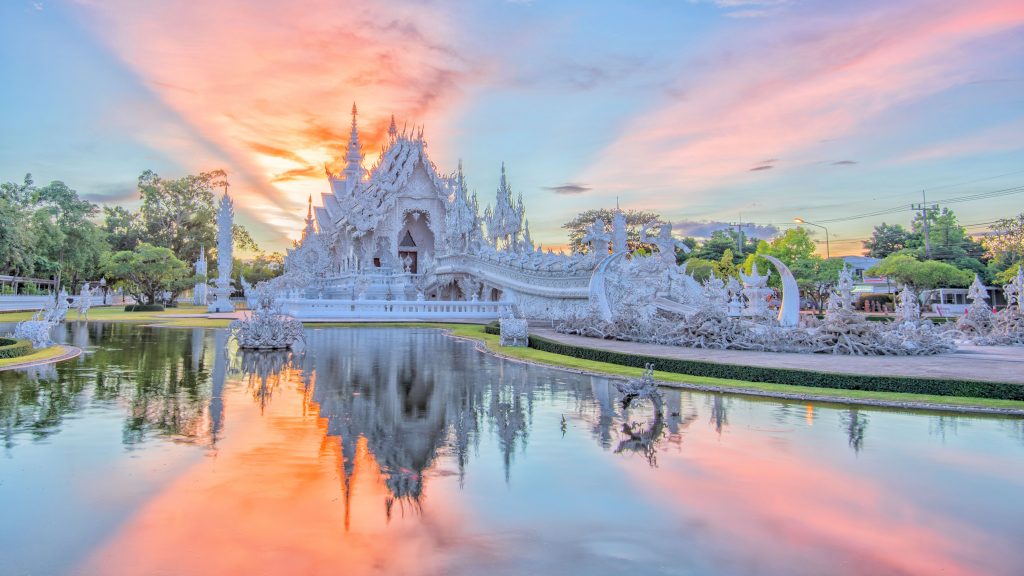
Sitting right on the border with Myanmar and Laos, the mountainous city of Chiang Rai is famous for its trekking in Lam Nam Kok National Park, with trails leading to stunning waterfalls such as the 70-meter-tall Khun Kon waterfall, lush forest, and hilltop tribe villages.
As with most Thai cities, temples are a huge attraction in Chiang Rai, with Wat Rong Khun (or White Temple) coming up at the top of the list. Wat Rong Khun is technically no longer a temple but a privately-owned compound redesigned and rebuilt by Chalermchai Kositpipat, one of Thailand’s most famous contemporary visual artists. Another popular temple is Wat Tham Pla (also home to a cave and thousands of wild macaques), which can be reached by climbing a staircase flanked by the guardian Naga serpents.
Tiny Wat Phra Kaew, famous for once housing the Emerald Buddha until it was moved to the Grand Palace in Bangkok, and Doi Tang mountain–home to a botanical garden, a former royal residence, and a temple with fantastic views–are also worth a visit.
Pattaya
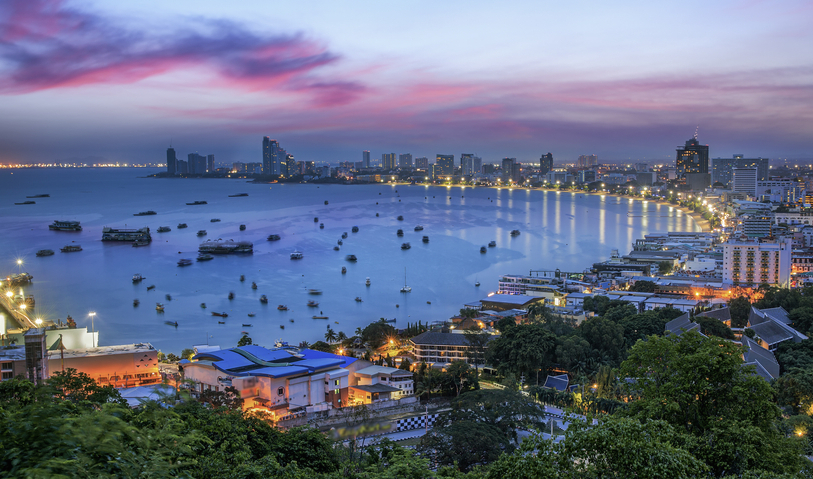
Once a quiet fishing village, Pattaya is now the closest beach getaway for Bangkokians, less than two hours away. While most visitors come here to escape the buzz of the Thai capital and soak up some sun, there’s much more to do in this beachfront town.
Hat Sai Kaew (Diamond Beach) and Koh Samet beach are good places to start your visit–they’re full of colorful food stalls, beach umbrellas, and stunning beach resorts. Koh Larn (Coral island) is famous for its glass-bottom boats that offer amazing views of the coral reefs, while Koh Larn Island is the prime destination for active pursuits such as parasailing and windsurfing.
For a quick sightseeing day trip from Pattaya, head to Chanthaburi Sapphire Mine–organized tours will give you a fascinating insight into the mining that’s been going on in the area for centuries. Or visit Siam Pattaya, an outdoor park that holds miniature replicas of world-famous monuments, including the Statue of Liberty, Angkor Wat, and the Bridge over the River Kwai.
If you want to see at least one temple while you’re here, Wat Phra Yai Temple is the one. Also known as Big Buddha Hill, this wat features an 18-meter-tall golden Buddha overlooking the entire town.
For a fun, relaxed afternoon, try some of Pattaya’s museums, including Ripley’s Believe It Or Not and the 3D museum, Art in Paradise.
Hua Hin

Once just a quiet town best known for being the king’s summer retreat, Hua Hin has become a popular beach resort destination. Don’t expect perfect turquoise waters or lively beach life here, though–this is more of a destination for those visiting with family, or singles who want to sunbathe in peace, away from the crowds.
Aside from the central Hua Hin beach, you can try nearby Cham Am Beach or Khao Takiab beach, home to Khao Takiab temple and hundreds of wild macaques. Hua Hin is particularly popular in December and January, when European tourists arrive here to escape their own freezing winter.
Just a few kilometers outside town towards neighboring Cha Am, you’ll find the Thai-Victorian style Maruekhathaiyawan Palace, built completely out of teak wood and once the summer retreat of King Vajiravudh (Rama VI). For adrenaline-charged water fun, try Black Mountain Water Park or visit The Venezia, a themed shopping center that even offers Gondola rides.
The Pranburi Mangrove Forest and Kaeng Drachan National Park are both within 1.5 hours from Hua Hin–they offer raised wooden boardwalks; waterfalls; and lots of wildlife, including wild elephants.
Pai
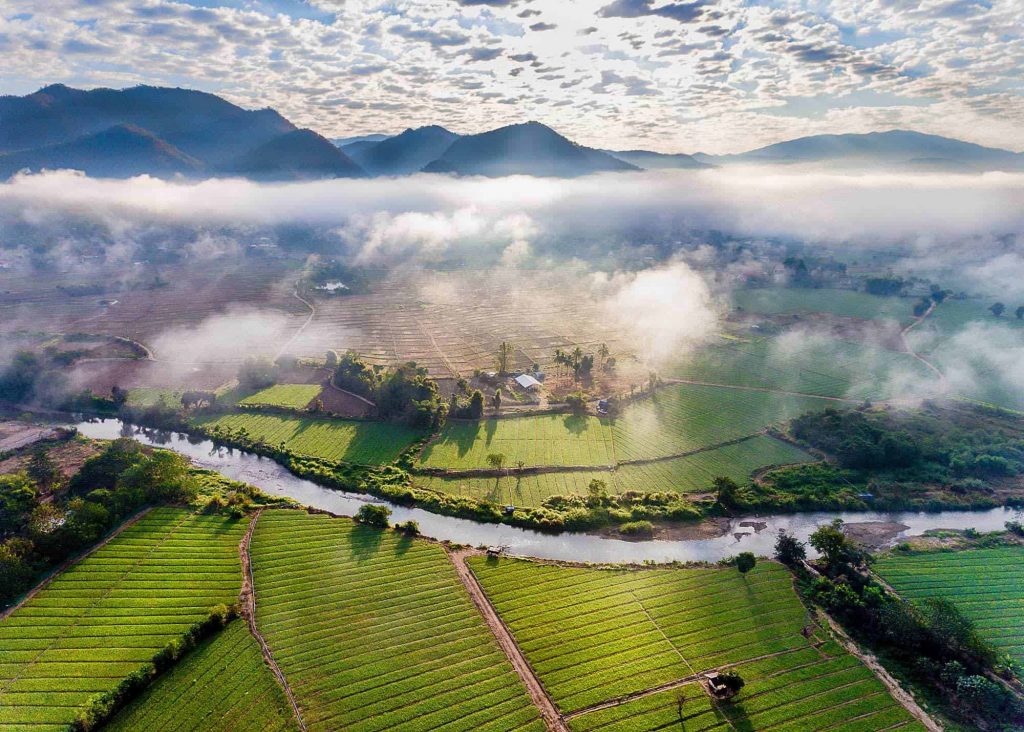
One of the most popular destinations in the Mae Hong Son province near the border with Myanmar, the small town of Pai has become a favorite among those looking for the slow, more rural side of Thailand. Once known as just a backpacker’s paradise, Pai is now attracting hikers and peace lovers as well – or just anybody wanting to explore the less-traveled roads of Thailand at least for a few days.
Pai is surrounded by densely covered hills rolling into green fields, majestic waterfalls, and hiking trails that seem to go on forever. It’s all the beauty of the authentic Thai countryside dotted with signs of the western bohemian world – organic food and quirky cafés included.
While Pai itself is small, the surroundings will keep you busy. There’s the Pai Canyon and its heart-stopping trails to hike, the Tha Pai Hot Springs for a warm bath, and rice terraces as far as the eye can see. You can climb the 353 steps to Wat Phra That Mae Yen for stunning views over the valley, or take a day trip to the massive Tham Lod limestone cave system.
Khao Yai National Park

Khao Yai National Park is Thailand’s oldest national park and still one of the most popular because of its large population of wild elephants. Covering an area of just under 2,000 square kilometers, this breathtaking park is home to rainforests, mountains, and grasslands. This variety of terrain means an equally rich fauna, with gibbons, jackals, and even bears calling the park home. Haew Suwat Waterfall, famous for a scene in Leonardo DiCaprio’s The Beach movie, can be accessed on foot when hiking the park.
Visitors can take to the trekking and biking trails here, or hire a park ranger to drive them to the usually inaccessible water holes where elephants congregate to drink.
Ko Phangan

As Thailand’s fifth-largest island, Ko Pha Ngan is a mix of rolling hills, lush jungles, and white-sand beaches. Compared to the neighboring island of Ko Samui, Ko Pha Ngan is relatively less developed, although it still offers plenty of activities for travelers and outdoor enthusiasts.
Diving is a popular activity in Ko Pha Ngan. The island is located near some of the best dive sites in the Gulf of Thailand, including the iconic Sail Rock site. Beachgoers are also spoiled for choice, as Ko Pha Ngan is home to over 30 different tropical beaches.
Ko Pha Ngan is famed for hosting the legendary Full Moon Party. Every month on the night of the full moon, Haad Rin Beach transforms into a lively open-air nightclub with live music, potent cocktails, and even fire rope skipping. The event attracts anywhere from 5,000 to 30,000 people each month.
Ko Samui

Although Ko Samui is Thailand’s third largest island, it was largely unknown to travelers until the two intrepid backpackers boarded a coconut boat and landed there in the 1970s. Word soon spread about the islands magnificent beaches, and today Ko Samui is one of the most popular travel destinations in all of Asia. Ko Samui offers a more convenient travel experience than other islands in Thailand too (besides Phuket) as it boasts an international airport.
Compared to its neighboring island Phangan, which is famous for its rollicking “Full Moon Parties” on the beach, Ko Samui is more developed, though it still has a number of quiet and secluded beaches. Even well-developed beaches like the four-mile-long Hat Chaweng have spots where visitors can relax away from the crowds. At the southern end of the beach around a small headland is Little Chaweng, or Chaweng Noi. Offshore are two small islets, one of which can be reached by wading.
Visitors who prefer a more social travel experience won’t be disappointed either. Na Thon, Ko Samui’s transportation hub, if full of lively restaurants and bars. The island is known for its coconut carvings and hand-printed batik clothing. Samui also has several important Buddhist temples worth visiting. Wat Khunaram features mummified remains of revered monks. Constructed in 1972, the Wat Phra Yai temple features a 3 meter (9 foot) high seated Buddha figure known as the “Big Buddha.”
The center of Ko Samui is a mountainous forest region with several stunning waterfalls, including a 20 meter (65 foot) waterfall that tumbles into a pool perfect for swimming. A well-developed road circles the island, making it easy to explore everything this popular travel destination has to offer.
Phanom Rung

Sitting on an extinct volcano in northeastern Thailand, Phanom Rung is a Hindu shrine complex regarded for its outstanding architecture. Located near the village of Nang Rong, this temple sanctuary was built by the Khmer culture between the 10th and 13th centuries as a dedication to the Hindu god, Shiva. Constructed of sandstone and laterite, Phanom Rung was built to represent Mount Kailash, the sacred home of Shiva.
The complex faces east, and four times a year the sun shines through all 15 sanctuary doorways. During these events the park extends its hours, and locals celebrate the Phanom Rung Festival around the April alignment, with ancient Brahmin ceremonies and modern sound-and-light shows.
Khao Sok National Park

Surrounded by towering limestone mountains and lush tropical forests, Khao Sok National Park contains some of the most spectacular landscapes in Thailand. It dates back 160 million years, making Khao Sok National Park considerably older than the Amazon rainforest.
At the heart of the park is Cheow Lan, a sparkling turquoise lake dotted with floating raft houses and colorful long-tail boats. Most notably, the national park is also home to the largest virgin rainforest in Southern Thailand. Visitors exploring the forest will come across cascading waterfalls, hidden caves, and groves of wild fruit trees. Other activities available include ziplining and kayaking and tubing on the Sok River.
Besides the picturesque scenery, many people visit Khao Sok for diverse wildlife. It’s believed that over five percent of the species on the planet live within the park. It’s common to see small creatures like Malaysian tapirs, wild boars, and pig-tailed macaques, although sightings of larger animals like Asian elephants and tigers are rarer.
Ko Chang

Thailand’s second largest island, Ko Chang is located off of the country’s southeastern coast near the Cambodian border. The island has everything that travelers want from a tropical vacation, from long stretches of sandy beaches to unspoiled rainforests. There are plenty of activities to pursue on the island too, including scuba diving, kayaking and jungle trekking.
When it comes to lazing on the beach in luxury, White Sand Beach is one of the most popular places to visit on the island. Located on the island’s northwestern corner, it’s the longest beach on Ko Chang. The central section of the soft sandy beach is lined with resorts and hotels. Hat Tha Nam on Ko Chang’s southwest coast attracts travelers looking for fun on a budget. From rustic bungalows to tree houses, visitors can find accommodations here on the cheap and spend the money that they’ve saved on the bars and restaurants popping up along the shoreline.
Among the many beaches on Ko Chang, Hat Khlong Phao is one of the most striking. Extreme low and high tides make this picturesque beach a beachcomber’s dream. Located at the north end of the beach is Laem Chaiyachet, a rock formation that’s been fitted out with a pier. It’s the perfect spot to watch the sun setting into the Gulf of Thailand.
Around 70 percent of Ko Chang is covered by mountainous forests, and taking hikes to view the island’s waterfalls offers visitors a refreshing break from sunbathing in the sand. A short hike from the beach of Khlong Phrao leads visitors to Namtok Khlong Phlu, the island’s largest waterfall. The falls drop in three cascading tiers. Those who climb to the top tier can reward themselves with a dip in a large pool.
Railay
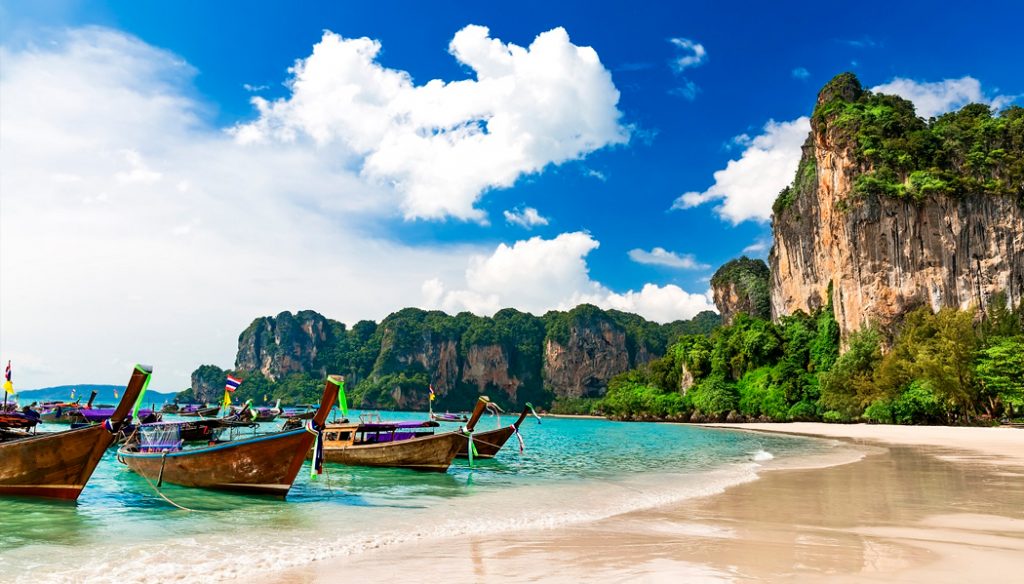
Railay (or Rai Leh) is a small peninsula in south Thailand that is only accessible by boat due to the high limestone cliffs cutting off mainland access. These cliffs attract rock climbers from all over the world, but the area is also a popular attraction in Thailand due to its beautiful beaches and quiet relaxing atmosphere.
Almost every patch of buildable land fronting in the eastern and western part of the peninsula has been taken over by bungalow resorts, and development is creeping up into the forest behind. But at least there are no high-rise buildings, and much of the construction is hidden among trees or set amid prettily landscaped gardens.
Koh Tao

Located off the southeastern shore of Thailand, the tiny 21 square km (13 square mile) island of Tao remained largely uninhabited until the late 1900s and has only recently been developed as a travel destination. With its white sandy beaches, lush green forests and majestic granite rock formations, it’s no wonder that its bare-amenity bungalows are making room for luxury resorts as more visitors become aware of the island’s natural attractions.
Koh Tao is best known as premier scuba diving and snorkeling location. With many shallow bays, easy currents and gorgeous coral reefs, many visitors come to Koh Tao to learn how to scuba dive or to upgrade their scuba diving certification. There are multiple diving schools in Mae Hat, the island’s main town, as well as in many other places around the island. Koh Tao’s coral reefs are home to a broad variety of marine life, including butterfly fish, batfish, whale sharks and bull sharks.
“Tao” is the Thai word for turtle, and some believe that the island was named for its turtle-like shape. Koh Tao also has several locations where hawksbill and green turtles come to breed every year, although their habitat has been threatened from the island’s increasing popularity as a tourist destination. In recent years, Koh Tao’s diving schools have banded together to help preserve the turtle breeding grounds.
Other popular activities on the island include rock climbing, sailing, mountain biking and game fishing. Mae Hat also has several schools that offer courses in Thai cooking and yoga. Sairee Village is the island’s hot spot and has an assortment of restaurants, bars and clubs.
Phitsanulok

Close enough to the World Heritage Site at Sukhothai for a pit stop, but overlooked by all but a few, this sleepy provincial town preserves one the country’s holiest and most beautiful Buddhas. In the ancient interior of Wat Phra Si Rattana Mahathat, and at the end of a colonnade of pillars elaborately decorated with gold filigree, sits the Phra Buddha Chinnara, vast and shimmering, crowned with a lotus-shaped halo and radiating nirvanic calm.
Trang
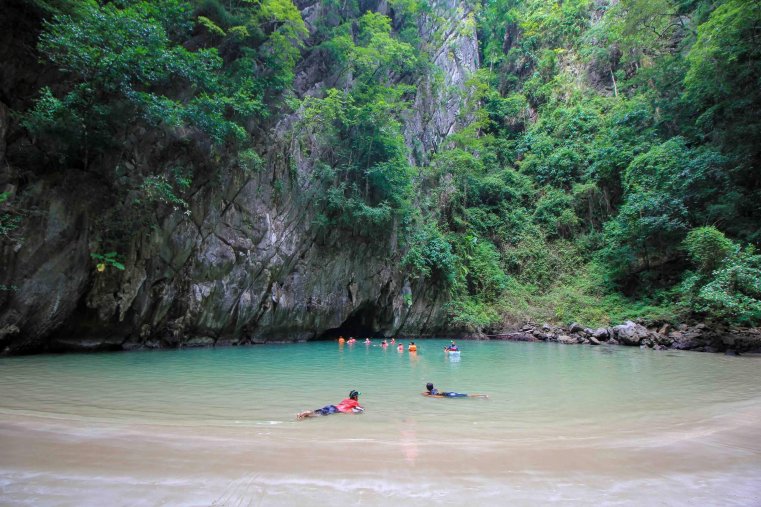
Yes, there are still unspoilt beaches and islands in Thailand. Especially in the southern province of Trang. Here the ramshackle wooden capital stands next to a long stretch of forest-backed bays and creamy white strands, protected by Hat Chao Mai National Park. Offshore islands include Koh Muk, Koh Libon, Koh Phetra and Koh Kradan, ringed with reefs, trimmed with white-pepper-sand and – for now at least – devoid of the big resorts that clutter the coast of neighbouring Krabi province.
Mae Hong Son
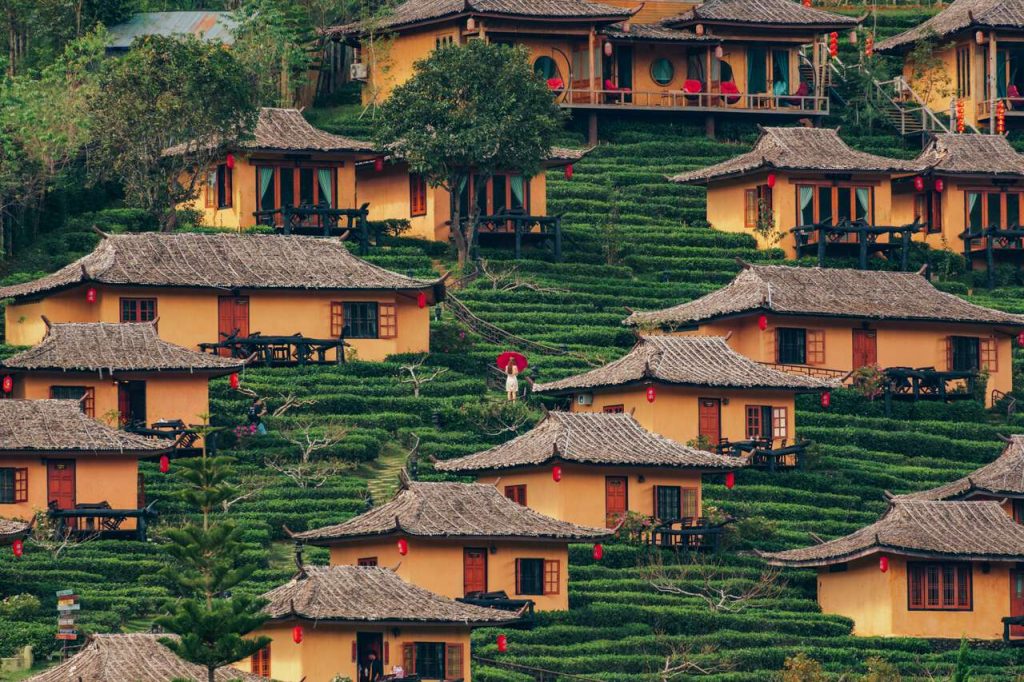
There are many people from the Shan group, Burma’s biggest ethnic minority, living in this mountainous and remote province in northern Thailand. Understandably so, as Mae Hong Son shares a border with Myanmar. The provincial town sees few international visitors, but that makes it all the more reason to go: for the photogenic nature and architecture, as you travel around the area. One of the main draws is the former hippie-populated town of Pai, a good place to base yourself if you love nature and a laid-back life. There’s plenty to stick on your to-do list, including Pai canyon, hot springs and waterfalls, and hiking and tubing along the river.
